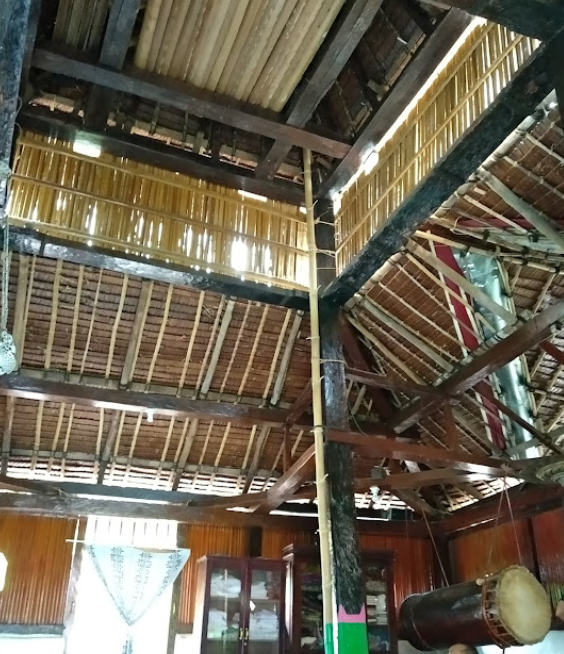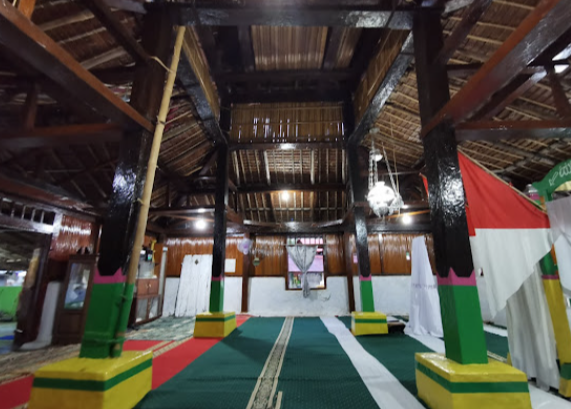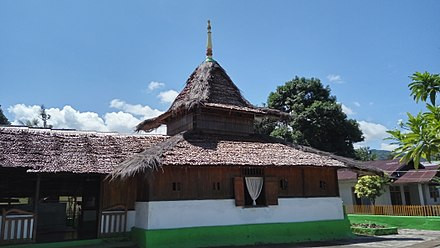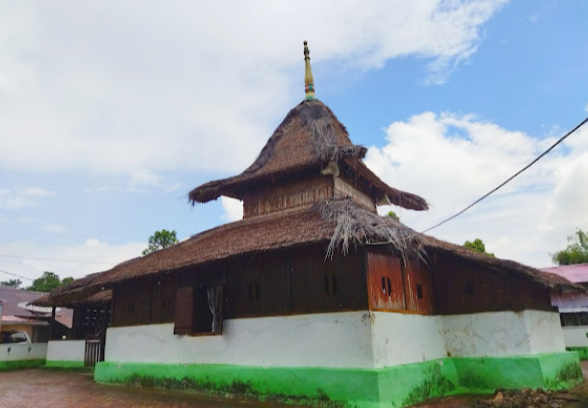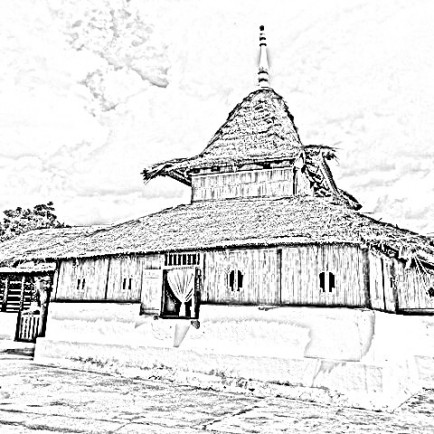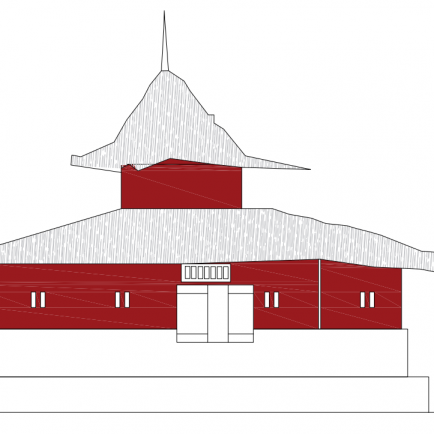Wapauwe Old Mosque
History
The first Wapauwe Mosque was established in Kampung Wawane, about 6 kilometers from its present place, in 1414. Its founder, Maulana Kiai Pati, was an Islamic proponent from the coast of Nukuhaly, Seram Island. This original mosque is constructed of sago frond walls and palm leaf roof. Kiai Pati converted five villages in the Wawane Mountains, namely the villages of Essen, Wawane, Atetu, Nukuhaly and Tehala.
In 1464, another group of Muslims led by Kyai Jamilu from the Sultanate of Jailolo, on the island of Halmahera in North Maluku. Jamilu continued the maintenance of the Wawane Mosque during his time in the village, as well as redeveloping the building into a larger mosque.
The Dutch arrived in early 17th-century and controlled Wawane. To avoid tension with the Dutch, in 1614 Imam Rijali, a descendant of Jamilu, led the exodus of the villagers to the village of Tehala, about 6 km east of Wawane. During the exodus, the Wawane Mosque was dismantled and transported to the new place.
The mosque was reconstructed on a plain where many wild mango trees grow. The mosque then received its present name Wapauwe Mosque, after the mango (wapa means "wild mango", and uwe means "tree" in local Kaitetu language).
The first major renovation of the mosque was in 1664 when it was twice transported and rebuilt without any changes to its original appearance. In the beginning of the 18th century, a spire on top of the mosque was installed. The spire represents the Arabic letter alif, a letter that symbolizes Allah. The second major renovation was in 1895 when a porch was added to the front and to the east of the original mosque. The renovation in 1895 also installed lime concrete reinforcement on the lower side of the wooden wall, and replaced the original coral gravel-layered floor with cement. The 1895 restoration was initiated by a local figure Hamid Iha.
Several minor renovations was undertaken during the post-colonial period without changing its appearance. In 1977, the Armed Forces' Military Districts of the area, the Komando Daerah Militer XVI/Pattimura, installed fences along the periphery. In 1982, the mosque was designated as a Cultural Property. An official plaque was installed and inaugurated by the Head of the Indonesian Institute of Sciences, Bachtiar Rifai. In the 1990s, the roof thatch was replaced with similar material. This restoration involved two dusun ("township") of Kaitetu village, Dusun Hila Kristen (a Christian majority) and Dusun Kalauli. The restoration was led by Head of the Adat Ir. H. Abdullah Lumaela. In 1993, the charity work of the 733rd Airborne Battalion undertook the construction of additional facilities, such as porches, pump wells, and garden ponds. Since 1995, the mosque is equipped with a loudspeaker from a government bank. Last restoration of the mosque was in March 2008 when the roof thatch was replaced again.
Urban and Architectural
The 15th century mosque has been maintained by keeping its original wooden form, using no nails but tied with ijuk fiber ropes.
The original wooden construction of the mosque is retained, using no nails or pegs. The main mosque is about 10 x 10 meters wide with an additional porch of roughly 40 square meters. The architectural style follows the typical traditional mosque architecture in Indonesia with multi-tiered roofs, supported with the saka guru pillars, and no minaret.
The multi-tiered roof is supported with four main columns known as the saka guru. The roof is topped with a wooden tip mounted perpendicular to the top. These main pillars were made of kanjoli or bintanggur wood (Calophyllum soulattri) which grows in abundance in the coastal area of Tanah Hitu.
The walls are covered in gaba-gaba (dried sago fronds) as well as the thatched roof.
The wooden main door is decorated with spearhead-shaped wooden ornaments inscribed with calligraphic writings of God and Muhammad on its four corners, and a turtle-shaped brass plate etched with a Salawat invocation.
Description
The Wapauwe Mosque is located in the old village of Kaitetu. The remains of Portuguese buildings lie such as the Portuguese Church and the Portuguese Trading Post, which were later established by the Dutch as a fortress A humble wooden mosque has been granted. Caring by both the Christian and Muslim communities in the villages. The 15th-century mosque is maintained in its original wooden form without nails. but tied with a fiber rope
References
https://en.wikipedia.org/wiki/Wapauwe_Old_Mosque
https://hmong.in.th/wiki/Wapauwe_Old_Mosque
Details
Location
C37M+WMG, Kaitetu, Leihitu, Central Maluku Regency, Maluku, Indonesia
Worshippers
50
Owners
Maulana Kiai Pati
Year of Build
1414
Area
40 m2
Drawings
Map
History
The first Wapauwe Mosque was established in Kampung Wawane, about 6 kilometers from its present place, in 1414. Its founder, Maulana Kiai Pati, was an Islamic proponent from the coast of Nukuhaly, Seram Island. This original mosque is constructed of sago frond walls and palm leaf roof. Kiai Pati converted five villages in the Wawane Mountains, namely the villages of Essen, Wawane, Atetu, Nukuhaly and Tehala.
In 1464, another group of Muslims led by Kyai Jamilu from the Sultanate of Jailolo, on the island of Halmahera in North Maluku. Jamilu continued the maintenance of the Wawane Mosque during his time in the village, as well as redeveloping the building into a larger mosque.
The Dutch arrived in early 17th-century and controlled Wawane. To avoid tension with the Dutch, in 1614 Imam Rijali, a descendant of Jamilu, led the exodus of the villagers to the village of Tehala, about 6 km east of Wawane. During the exodus, the Wawane Mosque was dismantled and transported to the new place.
The mosque was reconstructed on a plain where many wild mango trees grow. The mosque then received its present name Wapauwe Mosque, after the mango (wapa means "wild mango", and uwe means "tree" in local Kaitetu language).
The first major renovation of the mosque was in 1664 when it was twice transported and rebuilt without any changes to its original appearance. In the beginning of the 18th century, a spire on top of the mosque was installed. The spire represents the Arabic letter alif, a letter that symbolizes Allah. The second major renovation was in 1895 when a porch was added to the front and to the east of the original mosque. The renovation in 1895 also installed lime concrete reinforcement on the lower side of the wooden wall, and replaced the original coral gravel-layered floor with cement. The 1895 restoration was initiated by a local figure Hamid Iha.
Several minor renovations was undertaken during the post-colonial period without changing its appearance. In 1977, the Armed Forces' Military Districts of the area, the Komando Daerah Militer XVI/Pattimura, installed fences along the periphery. In 1982, the mosque was designated as a Cultural Property. An official plaque was installed and inaugurated by the Head of the Indonesian Institute of Sciences, Bachtiar Rifai. In the 1990s, the roof thatch was replaced with similar material. This restoration involved two dusun ("township") of Kaitetu village, Dusun Hila Kristen (a Christian majority) and Dusun Kalauli. The restoration was led by Head of the Adat Ir. H. Abdullah Lumaela. In 1993, the charity work of the 733rd Airborne Battalion undertook the construction of additional facilities, such as porches, pump wells, and garden ponds. Since 1995, the mosque is equipped with a loudspeaker from a government bank. Last restoration of the mosque was in March 2008 when the roof thatch was replaced again.
Urban and Architectural
The 15th century mosque has been maintained by keeping its original wooden form, using no nails but tied with ijuk fiber ropes.
The original wooden construction of the mosque is retained, using no nails or pegs. The main mosque is about 10 x 10 meters wide with an additional porch of roughly 40 square meters. The architectural style follows the typical traditional mosque architecture in Indonesia with multi-tiered roofs, supported with the saka guru pillars, and no minaret.
The multi-tiered roof is supported with four main columns known as the saka guru. The roof is topped with a wooden tip mounted perpendicular to the top. These main pillars were made of kanjoli or bintanggur wood (Calophyllum soulattri) which grows in abundance in the coastal area of Tanah Hitu.
The walls are covered in gaba-gaba (dried sago fronds) as well as the thatched roof.
The wooden main door is decorated with spearhead-shaped wooden ornaments inscribed with calligraphic writings of God and Muhammad on its four corners, and a turtle-shaped brass plate etched with a Salawat invocation.
Description
The Wapauwe Mosque is located in the old village of Kaitetu. The remains of Portuguese buildings lie such as the Portuguese Church and the Portuguese Trading Post, which were later established by the Dutch as a fortress A humble wooden mosque has been granted. Caring by both the Christian and Muslim communities in the villages. The 15th-century mosque is maintained in its original wooden form without nails. but tied with a fiber rope


